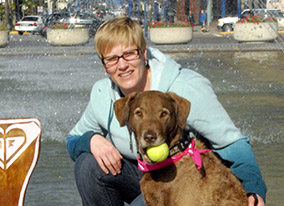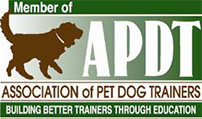Probably one of the most common problems I see trainers face is that their dogs can perform beautifully at home, or their training building, but then when they go to show, they have a different dog. This happening one time can be due to an unusual circumstance. Perhaps the dog has not been generalized to new places, and so finds this new place very distracting. There could be something unusual happening, say a thunderstorm and that affects the dog and so you see a difference in the behavior of the dog. Could be, might be, and still the thing that I find is that usually the dog has never been asked to work for that long between reinforcements.
Think how you feel, you go to work, you are used to getting a paycheck on Friday, but come Friday there is no paycheck, and no one says a word to you. Huh! So, you think about this, come back to work on Monday, everyone seems to be acting normally, so you hang in there, and you work until Friday, but then again, no paycheck. Everyone around you seems happy to be there, but what is going on? Come the next Monday, you go to work, no one says a word and then you show up late on Tuesday, stay out for a long lunch on Wednesday, leave early on Thursday and come Friday, why you get paid! Not just paid, but they praise you for your excellent work, give you a bonus and call you employee of the month. Huh!? Your very worst performance was closest to pay day, maybe they want that? Maybe that is why they finally paid you?
Most trainers have habits and one of our habits can be rewarding a particular amount of work that the dog is doing. Say, 10 steps of heeling, or rewarding after each halt. Maybe a trainer always rewards after every finish, or even every 30 seconds to 1 min. These become patterns to the dog, their “Friday paycheck”, so to speak, predictable time that the dog will be rewarded. Your dog may work wonderfully for 10 mins doing this, rewarding at these particular places or times. So, a trainer may think that the dog now is working 10 mins., time to show! Now the trainer takes the dog to the show and for the first time, the dog is not being rewarded at the usual time, no regular paycheck here. Sometimes you can see the dog start to falter, the dog is thinking what is going on? Why is this happening? The dog may start making errors that the trainer rarely sees at their normal training building; lagging, auto finishing and no sits at halts are very common. If you do agility it would be no start line stay, or missed contacts. Then the dog is done with this performance, one that is subpar by best, and is greatly rewarded! Do you see a problem here? Can you see how this could cause a long term problem if the trainer kept showing? Where is reinforcement never happening? Why, at a show, in the ring! The very place the trainer wants to have the best association, and where is all the reinforcement happening? Outside the ring! We are done, we are free, and that starts to be a big problem for a lot of trainers.
One of the most missed parts of training is actually conditioning the animal to work for a particular period of time; I call this an” interval “. This means a period of time that the training teaches the dog that they will work, too criteria, before getting a reward. You want to show this to your dog LONG before you go in the ring, and you want your dog not only comfortable working for the length of your performance between rewards, but loving it. If you are showing in Novice, a routine is between 3 to 5 or so minutes. Your dog should regularly be able to work for 6 or 7 mins. between rewards before you show.
Seven minutes is a long time! How do you do that? You start with 30 seconds to 1 minute for most dogs. You start to teach your dog that somewhere between 30 seconds and 1 min. of work will be (to criteria) rewarded. Not every sit at a halt will be rewarded, not every recall, but somewhere in there, with all exercises they do well mixed up, you will reward. When this period of time looks good, up the interval goes.
I will tell you that intervals are harder on the trainer than on the dog. Much harder. This takes planning, it takes record keeping and it takes the trainer being able to not push too fast so the dog thinks that Friday is not coming. For the dog, an interval is not so hard, if the trainer really conditions it. I often think of my Brittanys and how if there was a piece of kibble caught between the fridge and cabinets, they would work 30 mins. to try and get it. Or think about your dog knowing that you put their favorite treats on top of the fridge for later, how long will they work (it is work!) you for those? How many times will they come to you in the living room and rest their head on your arm to remind you of those treats? Or paw you? If you have a ball driven dog, how long will they keep putting the ball on your lap and staring at you and the ball until you throw it? Dogs do what works! You will go get the treats off the fridge, or throw the ball and in my case, with my Brittany’s, I will reach in between the cabinet and fridge and get the piece of kibble. Now think about that, the dog was sure that reward was coming and how much effort did they give? For how long? There is your challenge as a trainer, condition your dog to love that amount of working time, and guess what? The ring doesn’t mean that cookies never come, they are used to working for that period and it is not that big of deal to them. So freeing as a trainer!
I have an interval class that starts July 15th, want to start training? This was a huge positive leap in my training! If you are using positive reinforcement in your training, you need this. Right now we have dogs that do agility, obedience and freestyle in class. Every sport that asks for chains or sequences needs intervals. I am looking forward to this class, and hope to see you there. Registration is now open, class starts on July 15th.
If you think intervals sound boring, then you have not done the intervals my students and I have. This week in the One Happy Dog Trains podcast Trisha talk about indoor intervals in the AC, fun, fun, fun! The podcast is weekly and completely free. Follow this link to sign up.




I still chuckle about the first time I saw Margaret’s class on interval training. I was baffled how interval training would help my dog’s performance in the obedience ring. Interval training, after all, was physical conditioning to improve my dog’s strength and endurance! Now, I totally understand Margaret’s concept of interval training for obedience, and it has changed how I train my dogs for obedience and yields positive results. Thanks Margaret!